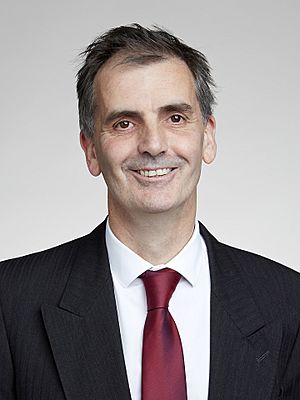James Dunlop (astronomer) facts for kids
Quick facts for kids
Jim Dunlop
FRS FRSE FInstP
|
|
|---|---|

Dunlop in 2016
|
|
| Born |
James Scott Dunlop
|
| Alma mater |
|
| Awards |
|
| Scientific career | |
| Fields | |
| Institutions |
|
| Thesis | The high-redshift evolution of radio galaxies and quasars (1987) |
James Scott Dunlop is a Scottish astronomer and a professor. He studies space, especially things far beyond our own galaxy. He works at the University of Edinburgh in Scotland.
Contents
Becoming an Astronomer
James Dunlop grew up near the Clyde coast in Scotland. He went to the University of Dundee to study physics. Later, he moved to the University of Edinburgh. There, he earned his PhD in astrophysics in 1988. His research was about redshift in radio galaxies and quasars. Redshift helps scientists understand how far away galaxies are.
His Work in Space Science
After finishing his studies, Professor Dunlop worked in England for seven years. He helped start a group that studies astrophysics at Liverpool John Moores University. Then, he returned to Edinburgh and has worked at the Royal Observatory ever since. He also spent two periods working in Vancouver, Canada.
From 2004 to 2008, and again from 2013 to 2019, he led the Institute for Astronomy (IfA) at the University of Edinburgh. In 2019, he became the head of Edinburgh's School of Physics & Astronomy.
Studying the Universe
Professor Dunlop is an observational cosmologist. This means he uses powerful telescopes to study the universe. He uses the world's largest telescopes, including space telescopes like the Hubble Space Telescope. His main goal is to study the chronology of the universe. He looks back in time to when the very first galaxies were forming. His research has received funding from important groups. These include the Science and Technology Facilities Council (STFC) and the European Research Council.
Awards and Recognition
Professor Dunlop has received many important awards for his work. In 2007, he became a Fellow of the Royal Society of Edinburgh (FRSE). He was also elected a Fellow of the Royal Society (FRS) in 2016. This is a very high honor for scientists. He is also a Fellow of the Institute of Physics (FInstP).
In 2014, he received the George Darwin Lectureship. Two years later, in 2016, he was given the Herschel Medal. Both of these awards came from the Royal Astronomical Society.

